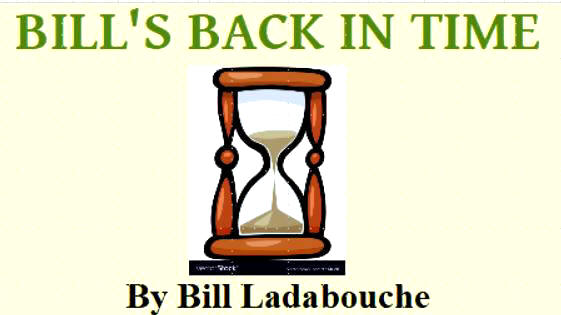
BILL'S
[Somewhat] WEEKLY COLUMN/BLOG PAGE

RACIN' IN PLACES
I RECKON THEY
MAYBE SHOULDN'T OUGHTTA TRIED
I guess anywhere you can
successfully run off racing programs is, at least, an OK venue; but there were
some places that it was probably more trouble than it was worth to try and stage
car races.
Some of the East's large old
fairgrounds tracks were obvious [and successful] choices. Football, baseball,
and other stadiums ? Maybe not so much. Indoors ? Hardly worth the effort. This
seemed particularly true in the formative years of stock car racing – the late
1940's and early '50's. One of the oddest places to give a go was the massive
Kingsbridge Armory, in the Bronx, New York City. In many partso f the country,
the favorable climate gave racing enough good days to satisfy their schedules
and programs – but the Northeast wasn't so lucky. So, one thing they thought
about was racing indoors.
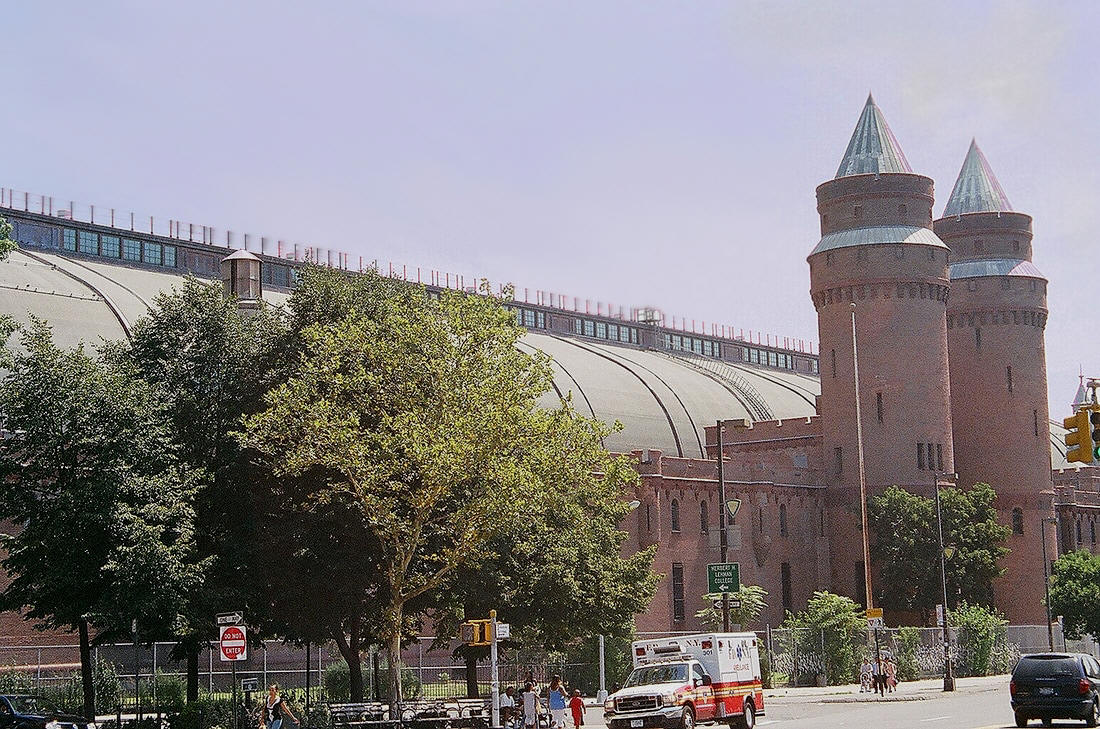
Speedway and Road Racing
History.com
The huge Kingsbridge Armory in the Bronx is
practically a wonder of the world, covering 5 acres.
After World War II, the sport of racing was absolutely blossoming all over the country. Of course, the more established open wheel categories like midgets, big cars, and sprint cars had a leg up, having already founded their governing and sanctioning bodies and having already established relationships with racing venues such as fairgrounds and the few auto race tracks in existence. Somewhere during that scramble to further the sport, somebody got the brainstorm of having indoor racing, especially seeing as the heavily – populated Northeast did not enjoy good weather for racing year around. The decision was made to try one of the largest buildings in New York City – the Kingsbridge Armory [or 8th Regiment Armory]. Even the railroad system went right up to the armory, and that was the way to travel in the city in 1947.
Built in the middle 1910's, it was the largest armory in the world, said to occupy around five acres of land. The huge “drill floor”, with its plentiful spectator seating, was as large as two foot ball fields. To be called the The Kingsbridge Armory Speed Drome, a flat track was built around the periphery of the drill floor for racing to commence in 1947. While the building was certainly large enough, there were no extra plans for what to do with the fumes that would come from the midgets that would be racing there.
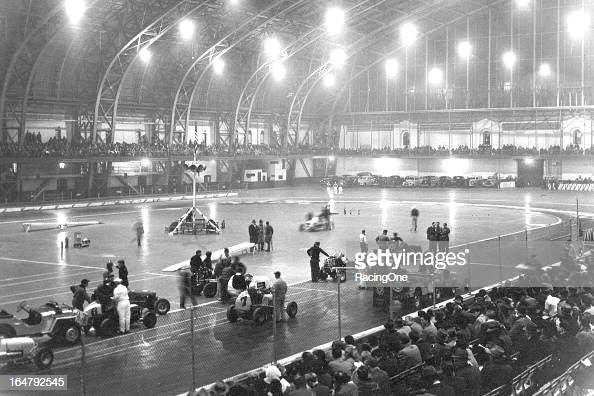
Getty Images
The immense
Kingsbridge Armory drill floor was more than ample
space for a small race track indoors. Below - A race
is flagged off
at the armory in 1947. LIFE magazine was interested
enough
to do an article.
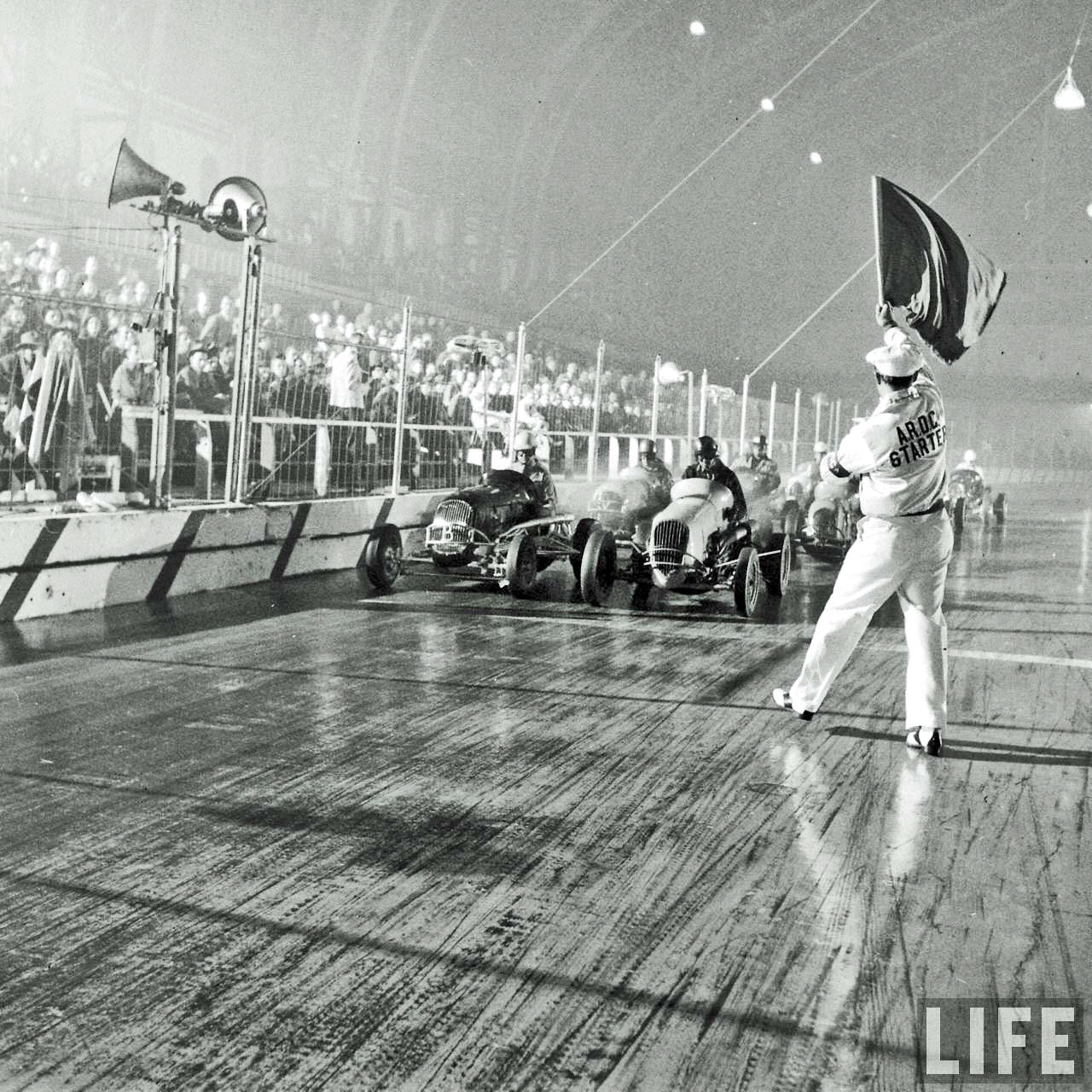
LIFE Magazine Photo via Surfref32
A number of midget events, involving most of the best teams the midget racing world had to offer, were run in 1947. Most aspects went well excect for the ventilation issue. Stories [and even photos] of spectators who were overcome with fumes, hanging over the edges of the balconies vomiting, were not too uncommon. With the way standards are today, that would be a reason for immediate cessation of any further racing there; but not in 1947. They ran quite a few programs.
Some photos I have recently come into possession of prove that the armory also tried some stock car racing. I can well imagine that the larger stock cars posed some additional problems in terms of racing space – and I would think the almost totally flat track would have been another issue. Some material written by Tony Avenengo suggests that there were also some outdoor races where “one had a choice of up to five tracks to race on nightly”.
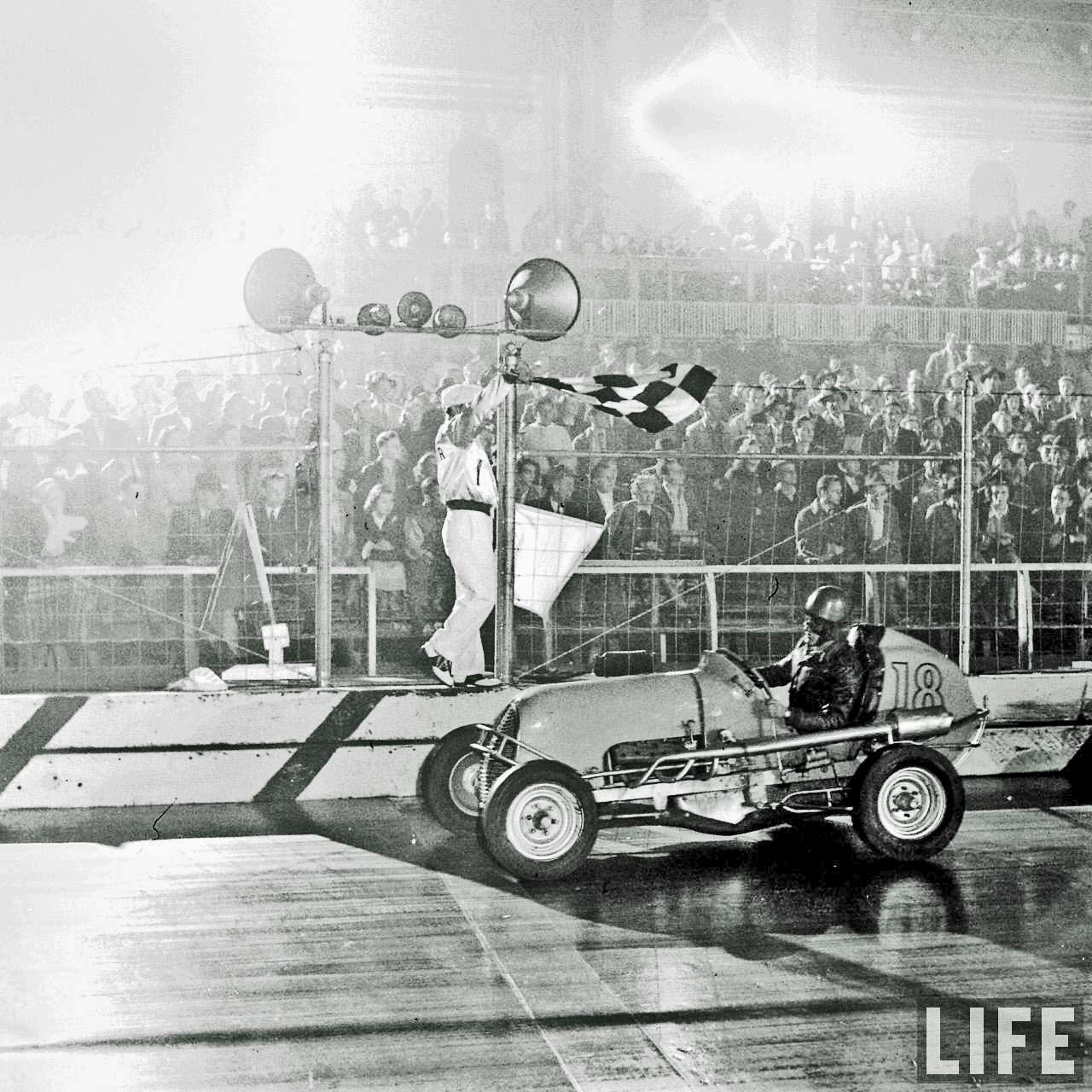
LIFE Magazine Photo via Surfref32
A winner is flagged at
Kingsbridge. In the background, you can
seating and the overwhelming fumes. Below – A driver
gets
bite and lifts the inside front in a haze of exhause
fumes.
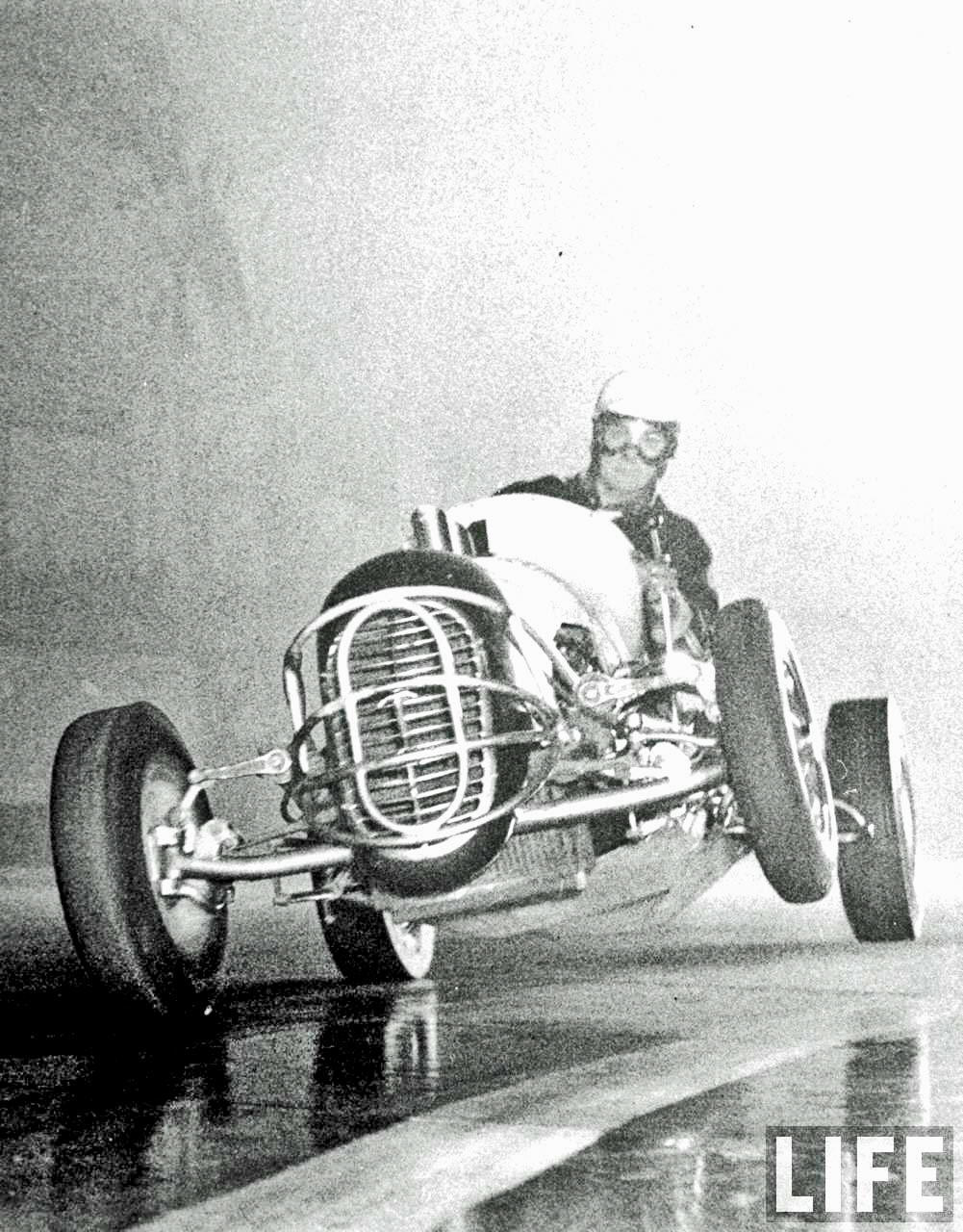
LIFE Magazine Photo via Surfref32
The indoor midget season involved November and December – and I cannot see much information that says it went into other years. However, two photos from Jeff Hardifer of the Wally Campbell Museum and some others that show midgets there in 1946 and 1948; but 1947 is the season that gets the most emphasis. I know there are are other photos of stock cars at the armory, but my shot of White Plains' Ray “Zero” Brown is the only one I can find.
It is not clear when they stopped having races there. As the number of race tracks in that part of the country grew, the appeal of putting up with the fumes, I imagine, decreased. They still try indoor racing at places like Atlantic City, but the ventilation systems are greatly improved. The Kingsbridge Armory, while being a building marvel in and of itself, was certainly one of the more iconic venues in the history of the sport.
KINGSBRIDGEARMORY_CYCLERACE Images 51
Word Press.com
Madison Square Garden
tried bicycle racing, but never
cars. People really wanted Kingsbridge as a
velodrome,
but never pulled it off.
Material from groups like the Eastern Auto Racing Historical Society show that – by the 1950's – indoor racing went through quite a time of popularity with racing at places like Cambria Co. War Memorial Coliseum in Johnstown, PA, the Raleigh, NC Coliseum, the Providence, RI Auditorium, Island Gardens, West Hempstead, NY, Long Island Arena, Commack, NY, the Utica, NY War Memorial, Camden, NJ Convention Hall, Pittsburgh Civic Arena, and Syracuse, NY War Memorial. So, either they figured out the ventilation or we had a lot of sick fans for a while.
Another, decidedly different, venue where the desire to have auto racing forced a somewhat less than ideal environment for viewing was up – on the Canadian border – in Newport, Vermont. Enthusiasm for automobile racing [particularly jalopy or stock car] was rising rapidly in the northern reaches of the Green Mountain State. Racing had been held at very crude locales like the Daggett sand pit in Holland and at more suitable places like the fairgrounds in Burke.
It occurred to a group of people in the greater Newport area that the stately old Veterans' Park, a horse racing venue with nice covered grandstands, would be one of the more ideal places they could race their heavy old car, most of which had the cages on the outside of the body. Officials of the track were not all that enthusiastic about he idea of this, particularly seeing as northern Vermont racing closely resembled a form of roller derby with small tanks.
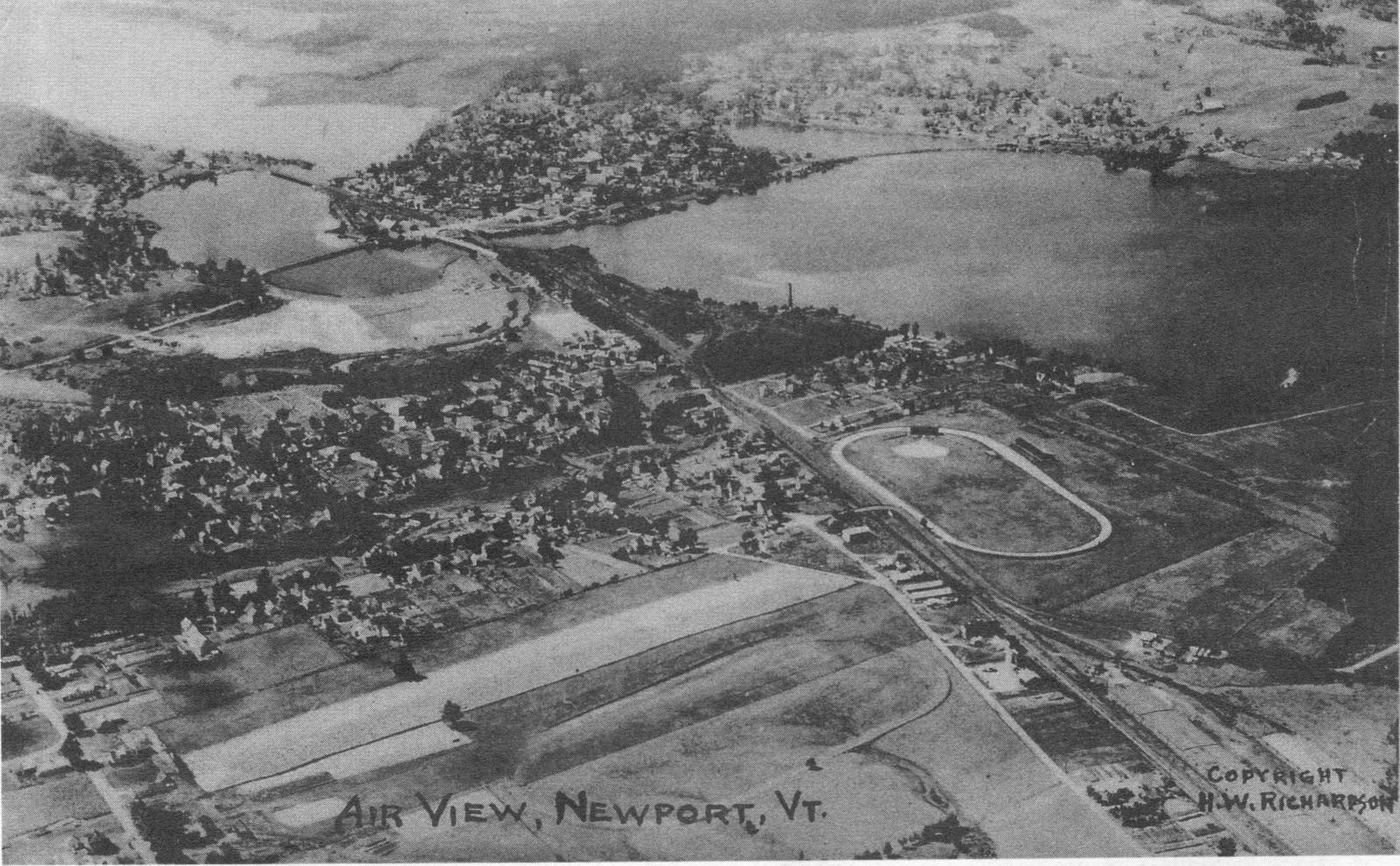
Richardson Photo Courtesy of Scott Wheeler
This is the only image that even
vaguely includes Veterans' Park. The track is the oval seen
more to the upper right of the photo. Below – A typical photo of Veterans'
Park action.
Courtesy of Al Hauver via Scott Wheeler
Unlike racing at that time at tracks farther south in Vermont, the local racing up there almost encouraged banging and knocking one another off the track. A local newspaper article about the Enosburgh Speedway [very similar in cars and technique] stated: “Harold Baker of Enosburgh was reaching for the stars in the free for all race when Hal Cleveland of Lyndonville plowed into him, raising Baker's car at least ten feet off the ground...” Another line stated :”Pop Chaffee of Montgomery Center, while trying to gain a position, was crowded over a bank.”
With this potential carnage in mind, Veterans' Park management made the stock cars race on a track that ran inside the original horse track and was separated from such by a snow fence. Judging from some photos of the action, this arrangement did not always keep the well – fortified stock cars on their own track. Most of the cars seen in a majority of the Veterans' Park photos shows cars looking very similar to those creating the carnage at Enosburgh [many WERE the same cars].
Hauver Family Photo via Scott Wheeler
This photo shows two
things: The potential for chaos at the Veternas' Park stock car races
and the fans who figured out that they could see better if they abandoned the
grandstands and stood by the snow fence. So much for safety precautions. The
light - colored section in front of them was the horse track. Below - This shot
shows some of the lighter - weight, faster Chittenden County cars on the track
in
Newport. It appears they had their own, separate race - perhaps to keep them
in one piece. The locals resented them.
Bob Bushey Family Photo via Jack Anderson
Word did get out what easy pickings these lumbering car would be for the lighter, faster cars that ran both at the tracks around Burlington, Vermont and also at the Northfield track. Invasions of these '32 and '34 Ford coupes would take place more and more regularly at not only Veterans' Park but at Morrisville, Green Mountain Farms Raceway in Sheldon, and at Enosburgh. The locals naturally took umbrage to this and expended a lot of energy [and even a few bucks] endeavoring to knock these interlopers off into the giggly weeds [if they could catch them]. The behemoths, mostly being sedans, had larger motors but the spectacle of them chasing the lightweights was a lot like a rhino chasing a cheetah.
Because of the friction between the two styles of racers, there had been a pretty serious riot at the short – lived [and possibly never – named] Morrisville track that had to be broken up by the National Guard – which had luckily been drilling nearby. Veterans' Park officials and the leaders of the club that was running the Newport races had to take some elaboratge precautions to ensure that this did not happen at the more sedate Newport track.
Courtesy of Ken Hitchcock via Scott Wheeler
This a fairly typical Veterans' Park car. The driver
poses proudly with what was actually
a fairly effective helmet. Most of them used an old
football helmet. Below - A few
of the Veterans' Park regulars did make the
transition to better stlocks cars, although
this didn't do him much good when he invaded the Twin
State Jalopy track at
West Lebanon, NH and was nailed by resentful locals.
Courtesy of Bill Baker
Photos of the racing at Veterans' Park seem to have come mostly from two sources: the majority of the scenes from within the stands are from someone in Burlington racer Bob Bushey's group; the others came from contributors like racers Bert Hauver and Ken Hitchcock. The grandstand shots serve to show what a poor line of sight those spectators had due to peering over two fences and the horse track to see the hectic action unfolding before them.
Racing at Veterans' Park lasted through those frantic years of the earliest 1950's and then died out [as did most of the early 20+ early tracks all over Vermont]. Some of the Veterans' Park teams adapted to the lighter, racier cars and continued to race elsewhere. While it lasted, that facility could at least claim that it had the best spectator seating in the state [even if they couldn't see much from it].
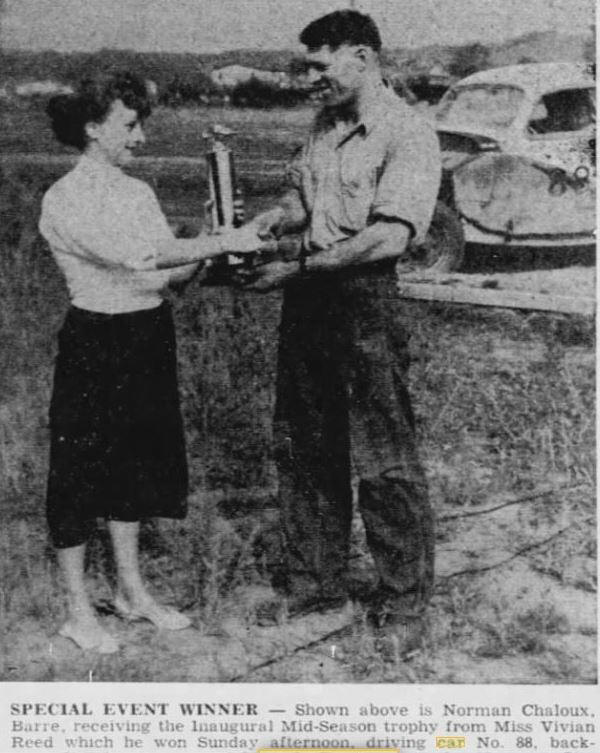
Newport Daily Express
This 1953 shot shows Norm Chaloux, another invader
from the Barre, VT area winning a trophy. The musculalr granite
cutter drove Armand LaQuerre's Rocket 88 - shown in
the background. Below - This infield shot, with the Frank
Hart family seated in the pickup in the foreground,
shows the grandstands at Newport.
Courtesy of the F.E. Hart Family via Arnie Hill
The next track had a fair run, but still did not make it out of the earliest days of stock car racing. Philadelphia, PA had gone through a series of sports stadiums as its number of c ollege and professional sports teams ebbed and flowed. At one ppoint, it had two professional baseball teams [the Phillies and the Athletics]. Then, the still – struggling National Football League landed a franchise in the Philadelphia area.
Frankford was essentially a part of the City of Brotherly Love, and the new football team was called the Frankford Yellow Jackets. Eventually, the team became the Philadelphia Eagles, but the Yellow Jackets' stadium remained. It was decided to get in on the burgeoning auto racing craze and put a small track around the periphery of the football field in 1948. This was not unusual as stadiums all over the Northeast and even in the Midwest were doing the same thing.
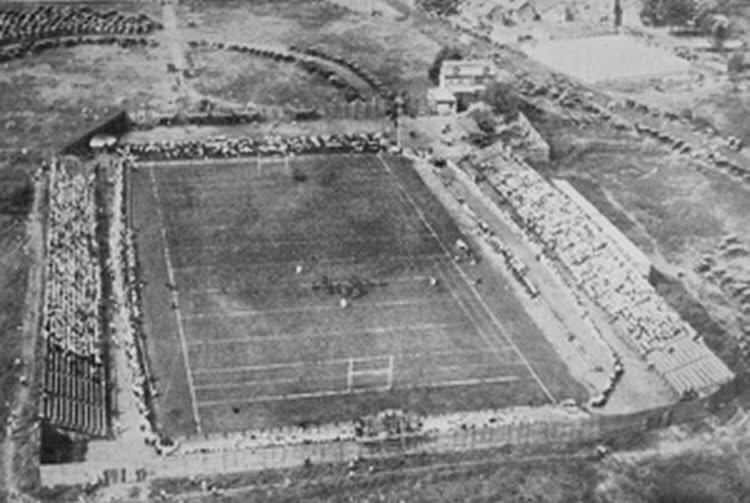
Blogspot Photo
A view of Philadelphia's Yellow Jacket Stadium - date
unknown, It is clear that the
track had not yet been installed. Below - A portrait
of the 1929 NFL Frankford
Yellow Jackets team.
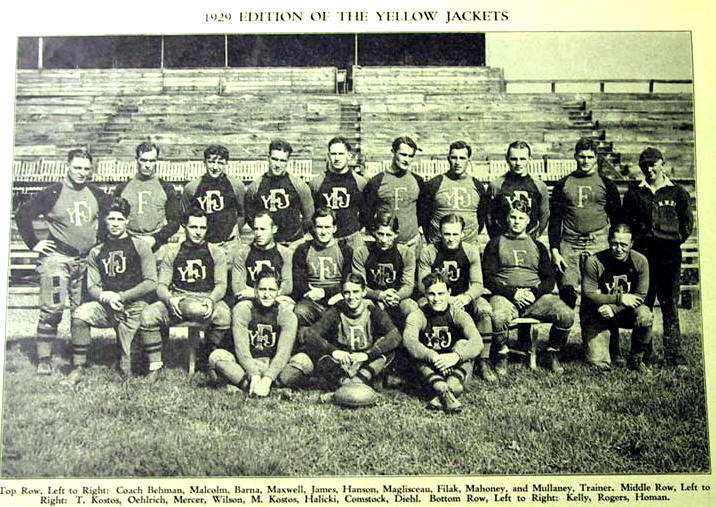
Sports Logos.net
Frankford was essentially a part of the City of Brotherly Love, and the new football team was called the Frankford Yellow Jackets. Eventually, the team became the Philadelphia Eagles, but the Yellow Jackets' stadium remained. It was decided to get in on the burgeoning auto racing craze and put a small track around the periphery of the football field in 1948. This was not unusual as stadiums all over the Northeast and even in the Midwest were doing the same thing.
The Yellow Jacket Speedway, at first, featured mostly midget auto racing. One racing program cover here [date unsubstantiated] seems to indicate that there was racing here as early as 1946. The Silhouet.com website claims that racing here began in 1939, after the football franchise moved. It also said that the track was only a fifth mile oval. That may have worked for the midgets but they wanted to run stock cars there by the later 1940's.
Apparently, one week in 1948, they ran an exhibition race on the track during the midget race program intermission. Whatever the result, they soon began to stage stock car races. Obviously, there was a lot of minor crashing as the mostly full fendered modified coupes from the racing – rich NJ/PA region began to vie for racing room. At this time, stock car racing in that area could match almost anything the Southeast had to offer. In fact, many of the drivers from both areas ran at each others' events.
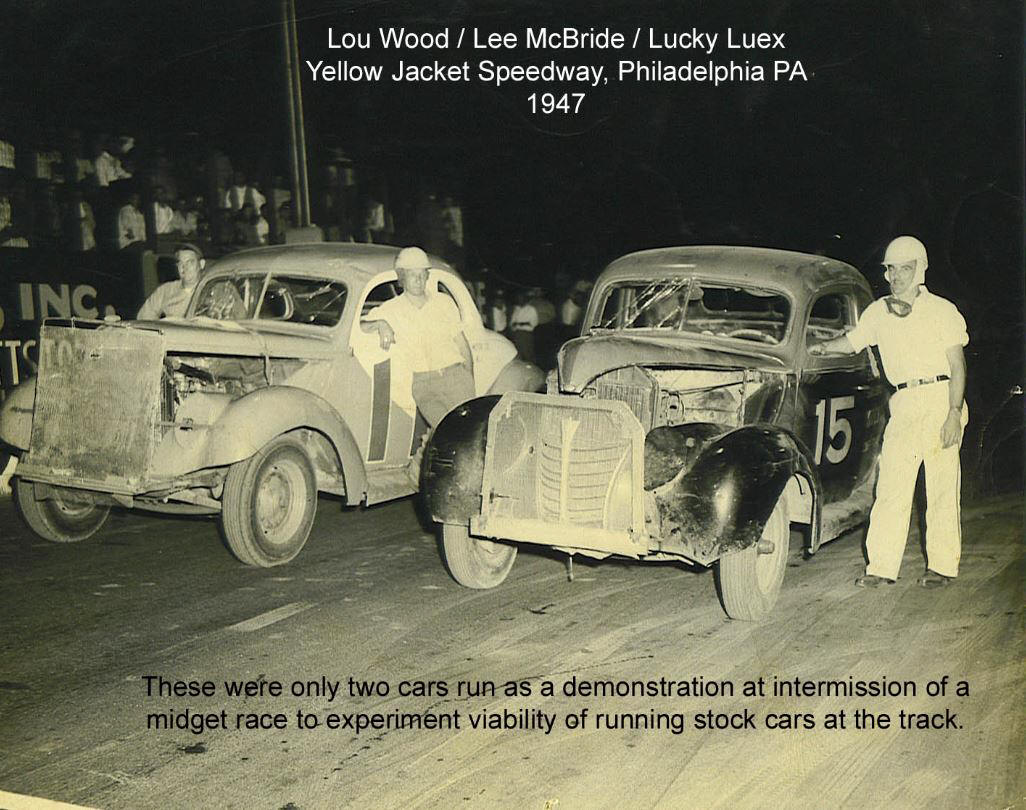
Courtesy of Jeff Hardifer
Lee McBride and Lucky Loux [inside] wait for their
exhibition race at intermission at Yellow Jacket
Speedway in Philadelphia. Below - The tiny fifth mile
looks too small here as Tommy Coates [91]rams
the legendary Pappy Hough [black car] and all hell
breaks loose.
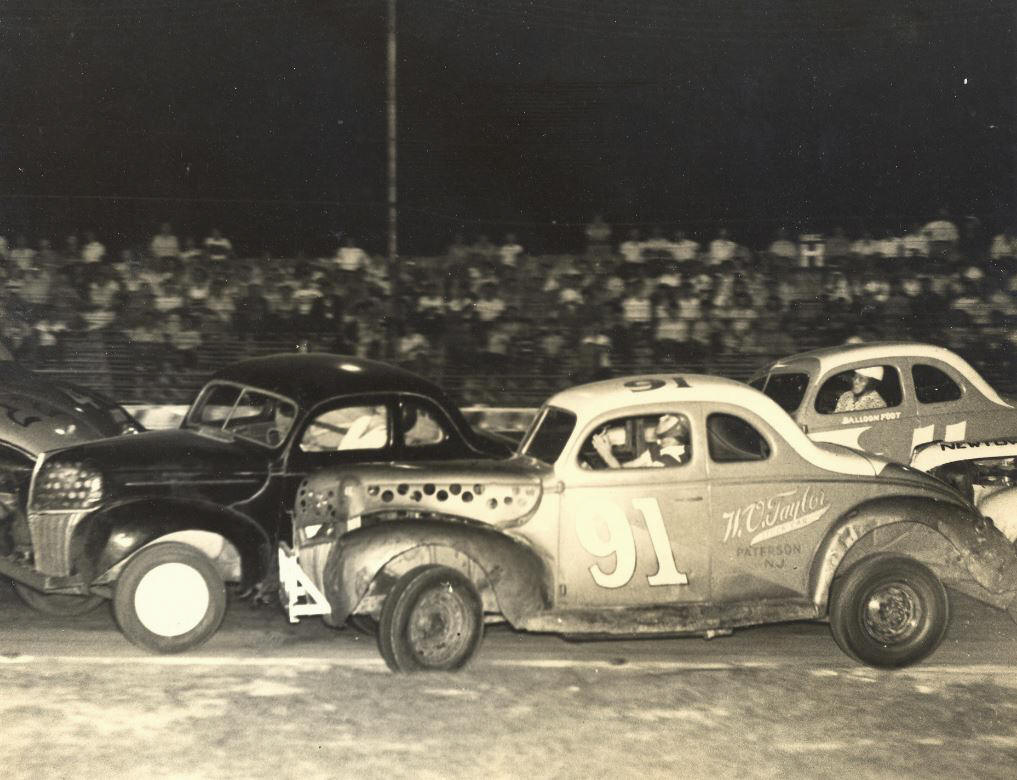
Courtesy of Jeff Hardifer
One thing is fairly clear. At some point around 1950, two things happened: 1.) Racing there ceased and the stadium was summarily torn down; and 2.) Gerber and Fried, promoters at Langhorne Speedway, got the idea to re-visit the name of Yellow Jacket Speedway and built a quarter mile track within the confines of the large Langhorne Speedway. That track would run only sportsman cars. Other stadium racing went on, big time at places like Ruppert Stadium, Newark, NJ; Veterans' Stadium, Bayonne, NJ; Hinchcliffe Stadium, Paterson, NJ; and Weissglass Stadium, on Staten Island, NY.
The last venue [ the one I know the least about] may have been the oldest. Parc Jarry [or Jarry Park] in Montreal was virtually unknown outside of Quebec until the newly – formed Montreal Expos baseball team of the National League had to sue it as their home park until the massive Olympic Stadium had not only been complete but was also free of the olympics.
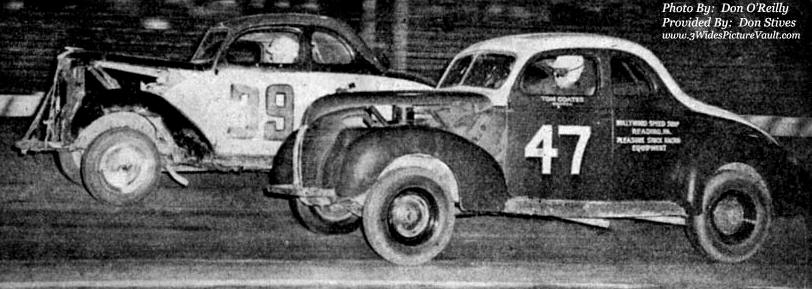
Don O'Reilly Photo via Don Stives and Three Wide's Picture Vault
Tommy Coates [shown here in the Joe Wolf 47] was the
big star at new Yellow Jacket
Speedway. Below - Jarry Park was scacely adequate for
a minor league team - let alone
the big time. Not much room for stock cars to race.
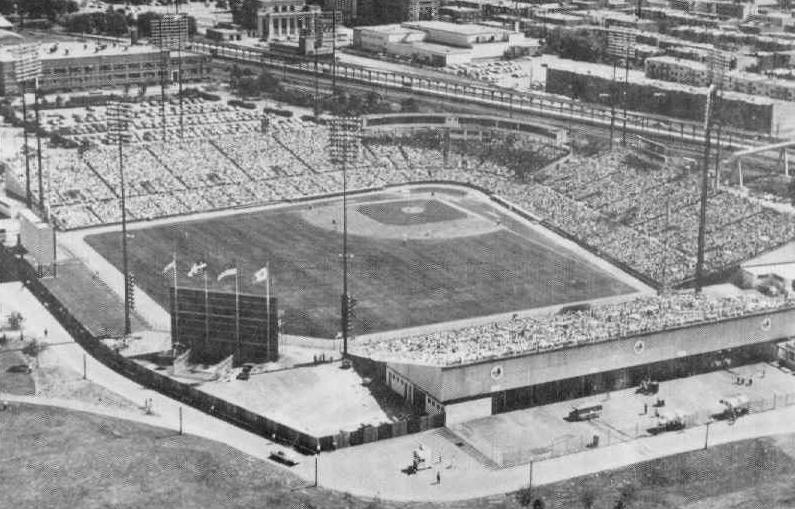
Uni Watch Photo
A very unimposing place, it barely served the purpose for the Expos [now the Washington Nationals]. For a brief while, they tried running stock car races in the park – well before it was used as a major league ballpark or much of anything else major. According to the Quebec gentleman who told me the story, the cars raced as much on the grass as they did on whatever track had been set up. Obviously, it didn't last long – despite the race – crazy atmosphere that pervaded the greater Montreal area for years.
There was a rich history of racing in Quebec on horse tracks including Bouvrette Speedway in St Jerome, where owner Gustave Bouvrfette insisted on starting the stock car races with the same gate truck [a Jeep pickup] that was used to start the trotters. Even the important Canadian National Expostition grounds in Ottawa were used [for quite a while] as a stock car track. Majestic Richelieu Park in Montreal was another such venue. But, apparently, nothing was screwier than the Jarry Park racing.
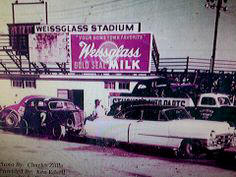
Pinterest
Weissglass Speedway [within the old Depresssion era
Weisglass Stadium had a good run
despite the fifth mile track and not enough room
outside for the pits. I got to see racing there.
Below - Vermont native Jackie Peterson lines up his
sprint car at Richelieu Park around
1950. The crazies with the cars were pretty tough on
the wooden fences at the old
horse palace.
Peterson Collection
Most of the venues I discussed had at least a couple of seasons of regular racing shows. They just weren't ideally suited, for one reason or another, to a long life except for the briefly – mentioned Weissglass venue on Staten Island.
Please email me at
wladabou@comcast.net
if you have any photos to lend me or information and corrections I could
benefit from. Please do not submit anything you are not willing to allow
me to use on my website - and thanks. For those who still don’t like
computers - my regular address is: Bill Ladabouche, 23 York Street,
Swanton, Vermont 05488.
AS ALWAYS, DON’T FORGET TO CHECK OUT THE
REST OF MY WEBSITE:
www.catamountstadium.com
Return to the Main Page
Return to the Main News Page
Return to the All Links Page
Return to the Weekly Blog Links Page